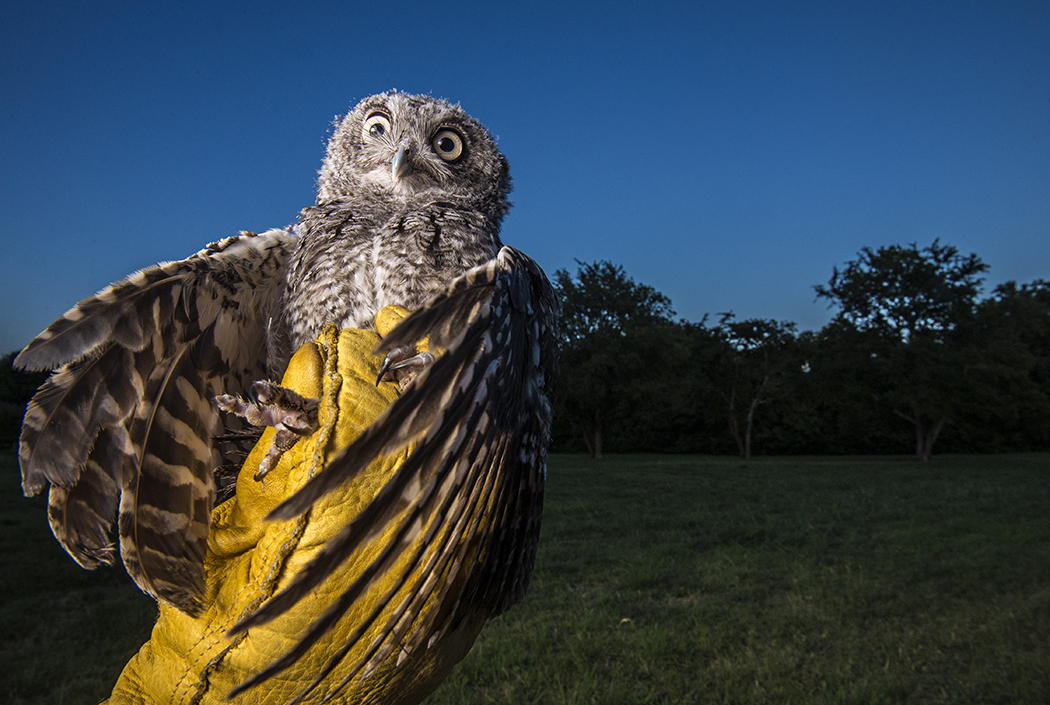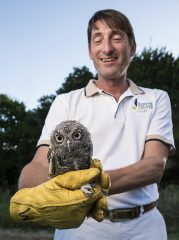
This 2-year-old screech owl is about to be released in our neighborhood after a stint at the Blackland Prairie Raptor Center. (Photo by Danny Fulgencio)

Erich Neupert prepares to release a recently rehabilitated screech owl near White Rock Lake, a popular release point. (Photo by Danny Fulgencio)
There’s an old story that mother birds will ignore baby birds if they are touched by humans. That’s not true.
The best thing to do with a baby bird is to leave it alone if it doesn’t look injured, or you can put it back in the nest.
“The nest is the best,” so says Erich Neupert, who grew up around the Mecca of ornithology: Cornell University.
These wise words are but a taste of the smorgasbord of knowledge in his head.
His grandmother, he says, is called the First Lady of Birding at the Ivy Leaguer because of the work she did with Peter Paul Kellogg and Doc Allen, founders of the institution’s ornithology school.
When Neupert was a child his grandmother still worked at Cornell.
“I spent lots of time there learning and studying,” Neupert says of his upstate New York upbringing.
[quote align=”left” color=”#000000 “]“Raptors are the best natural pest control.”
“She introduced me to ornithology,” Neupert says. “She put something in me about birds, and now here I am running a raptor center.”
The White Rock area resident now brings that education and spirit to North Texas as the executive director of the Blackland Prairie Raptor Center. It is the only raptor center in North Texas and works with more than 30 raptor species.
Neupert frees raptors all around our city, but White Rock Lake serves as one of the most popular release locations for rehabilitated birds of prey, he says. The lake is a perfect environment for screech owls, great horned owls, Cooper’s hawks and red shouldered hawks. Which is great news for the surrounding area, he adds.
“Raptors are the best natural pest control.” Especially screech owls, whose favorite foods include large cockroaches, sometimes called waterbugs, a common sight in North Texas.
“Whenever I tell people that, they’re excited to hear we release screech owls in the area,” he says. But cockroaches aren’t the only pests on the menu.
“Raptors are a top predator on the food web. They eat rats, snakes, mice, rabbits, some squirrel. The smaller ones eat insects. Their job is they kind of help keep some of that in balance.”
And balance is critical. Neupert says the best outcome is to return animals to where they are found, but that doesn’t always work. Blackland Prairie has a computer program that tracks all their releases and notifies them before an area is oversaturated with raptors.
“If we put them all in one area it wouldn’t be good for the area or the birds,” he says.
So far this year the center has seen more than 235 raptors come through and has released 17 screech owls around White Rock Lake. More are coming soon because quite a few of the small owls are still being treated. Birds you might spot at White Rock include two great horned owls, two Cooper’s hawks and two red shouldered hawks, all released by Neupert and Blackland Prairie.
In 2004 Neupert joined Blackland Prairie as a volunteer, along with five others. Two years later he was asked to take over operations.
“I wanted to see how we could grow and expand.”
At the time it wasn’t much more than an outreach effort. Today, they host 200 programs a year, have 14 educational birds to display and this year, they’re open to the public the first Saturday of every month and they’ve added a temporary raptor hospital.
“It’s getting quite busy,” Neupert says of the facility. “Just today we’ve received seven raptors and there’s another one on the way.”
The center also moved to an endangered Blackland Prairie north of Dallas, changing its name to honor the tall grass that used to cover more than 23,500 square miles of Texas from the Red River to San Antonio.
Overall plans for the center include an education facility, interpretive trails through native Blackland Prairie, demonstration gardens with native species and the creation of a raptor rehabilitation center.
The rehabilitation center will be tackled next, Neupert says. It will include a permanent hospital with a surgical center and will be capable of housing up to 900 raptors at once.
“It will make us one of the larger [centers] in the country.”
The permanent rehabilitation center is crucial because injured birds arrive for a variety of reasons. However, the most common reason the center receives calls, especially from our neighborhood, is due to baby birds found on the ground.
“Now, most of the time, those birds are fine. They’re just learning to fly and they don’t need our help,” he says. “We call them orphans, even though they aren’t truly orphans.”
The center also sees raptors that have flown into windows or get hit by cars. Some are sick after eating a rat or mouse that has ingested rat poison. Others, Neupert says, are even shot at, which is illegal. Birds also come in with second-degree burns on their feet because of fertilizer that has been left on lawns. Neupert says it happens when the fertilizer isn’t watered correctly.
“That takes about a month, once we get a bird in with those kind of burns, to get them off.”
If a bird has been injured like that, the center tries to find a new area to release them, keeping them out of harm’s way.
“We do a lot of scouting to find good areas for birds,” he says. “They’re part of a balanced ecosystem. It’s important that they’re out there.”
To learn more or to volunteer, visit bpraptorcenter.org. Or give to Blackland Prairie on North Texas Giving Day.






